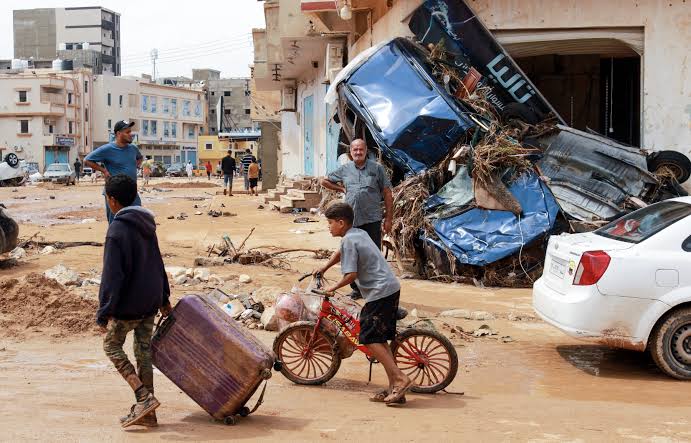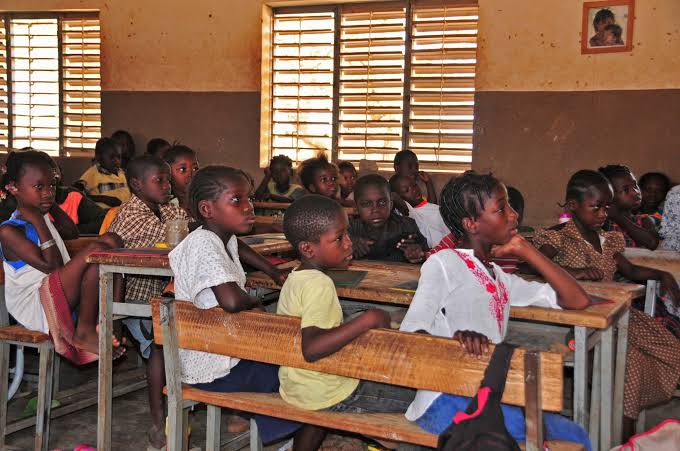
Faith Nyasuguta
Libyan authorities have expressed fear that the number of victims will exceed 12,000 people. A large number of those affected by the storms and flooding are likely to be migrants and internally displaced people.
Thousands are feared dead and missing in the aftermath of storm Daniel which made landfall in Libya on Sunday, September 10.
Strong winds dumped heavy rainfall on multiple coastal towns in the east, causing massive infrastructure damage, cutting off power and communication lines, and submerging vast areas. Devastating floods burst through two dams, sweeping away entire neighborhoods.
News reports indicate that Libyan health authorities estimated that “the number of victims will exceed 10,000 and about 100,000 people missing.” A three-day mourning period was declared this week and flags across the country were flown at half-mast.
Figures from the United Nations High Commissioner for Refugees (UNHCR) indicate that over 46,000 internally displaced people were hosted in the east of Libya before the devastating floods.
“The floods caused a mass displacement, adding to the number of people who were already displaced before Storm Daniel hit the country. However, estimates of flood-induced population displacement are not available yet,” UNHCR spokesperson Matthew Saltmarsh told InfoMigrants.
DERNA SITUATION CATASTROPHIC
The city of Derna, which sits on a river delta on the nation’s eastern coast, is the most affected and is reportedly inaccessible.
On social media, Derna residents posted videos showing entire residential blocks flattened along the Wadi Derna, a river that runs through the mountains and the city center. Local media reports described the situation in Derna as “catastrophic” with electricity and communications lines cut off. In a phone interview broadcast on al-Masar television station yesterday, Prime Minister Ossama Hamad declared Derna a disaster zone.
“This is a disaster on such a vast scale that it has affected everyone. Our teams on the ground have reported entire cities and towns that are no longer there. This is just another layer of suffering for the people of Libya,” Tommaso Della Longa, Spokesperson for the International Federation of Red Cross and Red Crescent Societies (IFRC) told InfoMigrants.
Della Longa said that three volunteers of the Libyan Red Crescent died in the disaster.
“We are extremely saddened by this. Our volunteers are first responders and also members of their own local communities impacted by this disaster,” said Della Longa.
Following a North Atlantic Treaty Organization (NATO) bombing and the fall of Muammar Gaddafi’s regime in 2011, Libya collapsed into a failed state. The country is divided and ruled by two rival administrations, one in the east and the other in the west. Both are backed by militias and foreign governments.
LIBYA MIGRANT SITUATION
More than 1,000 refugees and asylum seekers registered with UNHCR live in the east of Libya, including the areas affected by storm Daniel.
“UNHCR is aware that a larger number of forcibly displaced people that are not registered with UNHCR live in the areas hit by the storm and flooding,” UNHCR spokesperson Saltmarsh said.
In a report shared with migrant organisations, the International Organization for Migration (IOM) indicated that there were an estimated 410 families and at least 35 migrants displaced and sheltered in schools in Benghazi, as of September 11.
An April IOM report on the profile of migrants in Libya shows that there are an estimated 705,746 migrants living in Libya. Over half live in the western part of the country while about 30% live in the east, the area pummelled by storm Daniel.
The majority of the migrants, or about 80%, are men, mostly from neighboring Niger and Egypt.
An August IOM Detention Profile report, which provides a snapshot of conditions of detention centers under the Libyan government’s Directorate for Combating Illegal Migration, showed that there are an estimated 400 people in the migrant detention center in Abusliem. About 300 are women, four of whom were pregnant.
SQUALID CONDITIONS IN MIGRANT DETENTION CENTERS
Human rights watchdogs have long deplored the hellish living conditions in migrant detention centers. Under agreements with certain European Union states, the Libyan coast guard patrols in waters of the Mediterranean Sea.
People who attempt to reach Europe by crossing the Mediterranean are apprehended by the coast guard and forcibly returned to Libya and placed in detention centers managed by the Ministry of Interior.
Last month a shocking video circulated on social media and was published online by The Guardian newspaper in which an unidentified woman lay dead on the floor of a migrant detention center.
The woman was believed to be from Somalia and may have died from tuberculosis, a disease that reports said is common in cramped detention centers.
In 2021, rights group Amnesty International alleged that guards in detention centers forced women into sex in exchange for water and shot at detainees.
Despite Libyan authorities vowing to close detention centers where abuse is rampant, human rights violations have continued in newly opened or reopened centers, according to Amnesty.
RELATED:




